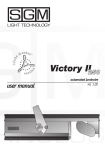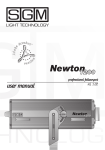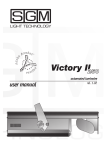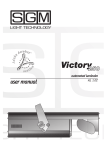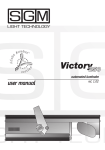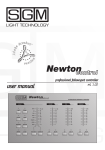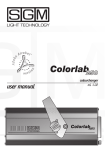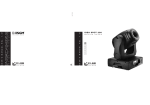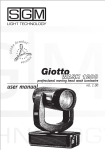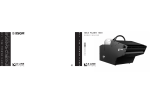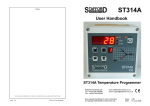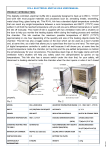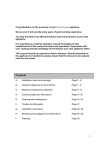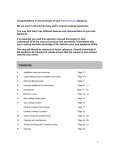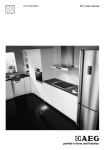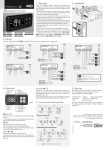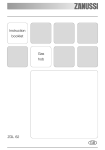Download Victory - Techni-Lux
Transcript
Victory250 user manual automated luminaire rel. 1.02 General warnings Carefully read the warnings contained in this manual, since they supply important instructions concerning safety of installation, use and maintenance. It is very important that this manual be kept with the equipment for future consultation. In case of sale or transfer of the equipment to another user, ensure that this manual always accompanies the equipment to allow the new owner to obtain information about the operation and the relevant warnings. • Not for residential use. • After unpacking check the integrity of the equipment. In case of doubt, do not use the equipment, and contact an authorized SGM Technical Service Centre. • The packaging materials (plastic bags, expanded polystyrene, nails, etc.) must be kept out of reach of children since they are potential sources of danger. • This equipment may only be operated by adults. Do not allow children to tamper with the machine or play with the product. • The electrical and mechanical work necessary for the installation of the equipment must be carried out by a qualified electrician or by a competent person. • Before connecting the unit, check that the data on the registration plate is the same as that of the electrical grid. • Avoid using the equipment: - in places subject to excessive humidity - in places subject to vibrations or knocks - in places with temperatures higher than 45°C or lower than 2°C - Protect the equipment from excessively humid conditions (the optimum values are between 35 and 80%). • Do not disassemble or modify the equipment. • Prevent inflammable liquids, water or metallic objects from penetrating the equipment. • In case of spilling liquid on the equipment, immediately disconnect the power supply of the mixer. • The minimum distance between the projector and the surface to be illuminated must not be less than 1.5 m. • In case of serious functioning problems, switch off the equipment and contact the nearest SGM retailer or the manufacturer directly for inspection. • Avoid opening the equipment: there are no parts repairable by the user. • Never try to repair the equipment alone. Repairs carried out by inexpert persons may cause damage Always insist on original spare parts. Protect the environment: do not throw the packaging in your dustbin, but return it to your retailer or take it to a collection point for special waste disposal. EN I D F E appendice page 1 or serious malfunctioning. Contact the nearest authorised Technical Service Centre. Index 1 General warnings 2 Index 3 Main characteristics 3 Lamp 3 Optic system 3 Focusing 3 Mirror 3 Strobe 3 Dimmer 4 Iris 4 Shutter 4 Colour 4 Gobo 5 Technical characteristics 6 Positioning and focusing 6 Positioning 6 Focus adjustment 7 Victory 250 maintenance 7 Access to inside 7 Lamp mounting and replacement 7 Cleaning/ Periodic checks 8 Colour replacement 8 Gobo replacement 8 Start addresses 9 Victory connections 10 “Options” Dip-switch 10 Pan/Tilt - Normal/Reverse 10 Mirror 8/16-bit res. 10 Auto/Remote mode Control channels 11 ch 1 - dimmer 11 ch 2 - colour 12 ch 3 - gobo 13 ch 4 - shutter/strobe 13 ch 7 - reset page 2 10 Made in Italy by SGM Electronic Printed in September, 1998 • Rel. 1.02 Main Characteristics The intelligent projectors of the Victory series spring from a design philosophy which all SGM products have for years had in common. These new scanners, because of their avant-garde performance, certainly take top place among the best in world-wide production. The accurate study of the functions, the search for innovative materials, the continuous technical updating have led to the realization of a certainly unique product: Victorys are projectors suitable for a multitude of applications. The vast and pluridecennial experience of SGM in the sector of light control systems has allowed developing a product with high reliability and precision, of which the mechanics, optics and electronics are entirely designed by our own research laboratories. This allows absolute mastery of the know-how and optimisation of the quality/price relation. As every SGM product before commercialisation, the Victorys have brilliantly passed the long testing period and the strict tests they have had to undergo - this is synonymous with high quality and reliability. The particular care over the aesthetics, and the optimisation of the outer structure aimed at functionality, allow easy installation in any position and extremely fast technical intervention. The Victorys are constructed in conformity with the CE regulations currently in force. Lamp The Victorys use an extra low-voltage incandescent halogen lamp with a 2-pin connector, without doubt the ideal lamp for this type of projector, since it combines good reliability with long life (about 300 hours), It has surprising luminous power at ridiculously low cost, absolutely incomparable with other metallic iodide lamps mounted on projectors of the same type. Optic system The special SGM-designed parabola able to concentrate the luminous beam, and the condenser lens in selected glass with a high transmission coefficient, subjected to special multilayer antireflection treatment, exalt the brilliance and luminous power of the Victorys whose brightness is positively astounding. Focusing Focusing the Victorys is extremely easy, fast and with absolute precision from the screw panel located on the front of the projector (Focus). Focusing is accurate on all the gobos as they are all arranged on the same wheel. Mirror The mobile mirror of the Victorys has ultra-high reflection able to reduce the loss of luminous yield to a minimum. The scanning time is 0.5 seconds for the 90° Pan and 0.3 seconds for the 180° Tilt. Extremely elaborate software and the use of first-class motors have allowed obtaining a movement capability which is ultrafast, precise and very linear even at lower speeds. Moreover, the Victorys accept 16-bit control which ensures a linearity of movement unbeatable among the projectors in this range. Mirror scanning can also be inverted to facilitate installation and programming. The stroboscopic effect of the Victorys is extremely fast for a projector of this category and may be adjusted by the operator to a frequency from 1 to 9 flashes a second. Dimmer The Victorys are also fitted with a dimmer function so that the light intensity may be dimmed from 0 to 100%. EN I D F E appendice page 3 Strobe Iris The Victorys do not have a mechanical iris, but the 8-position gobo wheel has a position to shape the luminous beam, thus obtaining a narrower beam which, for example, can be directed at a mirrored globe, or used to satisfy any other special need. Since the gobo is interchangeable, the amplitude of the luminous beam may be selected from the many available. Shutter A shutter is available on the Victorys, which may be activated instantaneously to block the luminous beam output. Colour 8 base colours are available on Victory (7+white) obtained through top-quality They are all easily interchangeable, so that also personal requirements can be satisfied. The colours may be selected as follows: • fixed positions, full colour • intermediate positions for two-colour beams • variable-speed rotation to obtain a spectacular rainbow effect • passage from one colour to another with or without blackout. • synchronization of the colour change with the music on fixed positions (Music Hard). The passage between the different colours is imperceptible to the human eye as it is extremely fast (the absolute fastest among the projectors in this range) and occurs in 0.08 sec. Gobos page 4 The Victory gobo unit consists of a single wheel with 7 images and one empty position. All the gobos are easily interchangeable so that the operator may install new figures easily and quickly. The gobo change occurs in fast imperceptible mode, or in analog mode with a slow passage from one figure to the next. Technical Characteristics Power supply: 90÷260V - 50/60Hz - Universal, automatic voltage change. Lamp: 250W 24V-EVC M/33, G6.35 connector - Life approx. 300 hours. Absorbed power: 300 W Optic unit: Mirrored parabola with very high luminous yield, designed for Victory. Optic system: Mirrored parabola + 70mmø lens + 90mmø lens, screw focusing. Lenses: In glass with high transmission coefficient. Mirror: Ultra-high reflection, in special glass. Electronics: Entirely developed by engineers of the SGM Research & Development Laboratory. Has a power supply card (CS 0207) and a logic card (CS 0208). Settings: By means of dip-switches, to address the control channels of the projector and to set the selectable options: - PAN/TILT scanning inversion; - 8 or 16-bit mirror movement resolution; - Control mode: Remote (from remote control), or Auto for automatic functioning independent of the projector. Motors: 5 a micro-stepper motors, 5 DC motors. Input: Digital serial signal DMX512 or RS232/423. Control channels: ch1 - dimmer / ch2 - colour / ch3 - gobos / ch4 - shutter/strobe / ch5 - pan ch6 - tilt / ch7 - gobo rotation / ch8 - palette / ch9 - prism and prism rotation ch10 - reset / ch11 - pan 16bit / ch 12 - tilt 16bit Mirror movement: Mirror rotation by means of 2 extra high-precision micro-stepper motors and controlled by the relevant control card. Option to invert mirror scanning. Safety regulations: The Victorys are in conformity with current CE regulations. Safety devices: IP20 degree of protection. Automatic power cut-off in case of overheating or cooling system operation failure. Cooling system: Forced through 1 axial fan. Body: In die-cast extruded aluminium. Epoxy-powder enamelling. Mounting bracket: In epoxy-powder enamelled steel. Installation position with adjustable inclination over 110°. Dimensions: cm 18 x 65 x 35. Weight: Kg 13,5. page 5 SGM Elettronica reserves the right to make improvements and modifications to its products at any time. Always refer the manual to the equipment it pertains to in order to avoid mistakes and straying from the actual functions as illustrated in the manual. EN I D F E appendice Positioning and Focusing Positioning To position the projector, the channels must be set as follows: Channel 1 Channel 2 Channel 3 Channel 4 Channel 5/6 dimmer colour gobos shutter/strobe pan/tilt 100% open white no figure open centre position Position the projector rotating it on its support bracket, then lock it in the desired position with the knobs. Focus adjustment To adjust the lens, the channels must be set as follows: Channel 1 Channel 2 Channel 3 Channel 4 Channel 5/6 dimmer colour gobos shutter/strobe pan/tilt 100% open white position on a figure open in position on the point where focus is desired Focusing the Victorys is very easy, fast and with absolute precision through the screw knob located on the front of the projector (Focus). Focusing is accurate on all the gobos as they are all arranged on the same wheel. Victory focus focus Victory focus Victory page 6 focus Victory 250 Maintenance Access to inside Victory has a particular way of access to the inside of the projector. Remaining fixed as installed, the projector can be opened exactly halfway in longitudinal direction, thus allowing easy access to the inner parts in order to carry out any necessary operation, be it cleaning, lamp change or service of any mechanical or electrical part. To open the projector, unscrew the 2 knobs on the front (Fig. 1), taking care that the lower part does not drop downwards suddenly when the screws are undone. A locking lever (Fig. 3) will automatically hold it open at maximum travel. fig. 3 Victory focus fig. 1 fig. 2 Lamp mounting or replacement Projector cleaning / Periodic checks Cleaning the optics - internally and externally - is determining for maximum luminous yield and should periodically be carried out. The cleaning frequency above all depends on the place where the projector operates. In particular, a humid environment with a great deal of smoke or dust favours greater accumulation of dirt on the projector optics. Clean with a soft cloth using normal window-cleaning products or denatured alcohol, always carefully drying the parts. Clean the external optics at least every 15-20 days and the internal optical unit (condenser lenses, parabola) and gobo unit EN I D F E appendice page 7 WARNING: Before replacing the lamp: - Evaluate the effective necessity to replace the lamp (average lamp life about 300 h). - Disconnect the projector from the mains. - If the projector was on, before opening it, wait for the lamp and the internal mechanical parts to cool down (10÷30 minutes) Remove the burnt-out lamp. Be extremely careful not to touch the optics, the parabola and the lamp with bare hands, since the residuals subjected to high temperatures burn, causing the parts to blacken and irreparably damaging the lamp. Proceed with mounting the new lamp placing it carefully in its housing. FOR GOOD PROJECTION IT IS VERY IMPORTANT THAT THE LAMP FITS PERFECTLY IN THE SOCKET. After each lamp replacement it is recommended to carry out a complete cleaning cycle. After carrying out the necessary operations, before pushing the lower part towards the top (Fig. 2) to close the projector, release the locking lever lifting it towards the top (Fig. 3). Screw down the 2 knobs one after the other, taking care that these have properly hooked the lower part to prevent it from suddenly dropping downwards. (including the rotation system) at least every 40-60 days. To ensure an always perfectly efficient projector, a general overall inspection every 700 hours of operation is recommended. Checking of the electrical and mechanical parts must be carried out by technical staff. Colour replacement Open the projector after disconnecting it from the mains. If it was on, wait for the lamp and the internal mechanical parts to cool down (about 30 minutes). The colour wheel consists of two parts between which the seats of the colour filters are located. To replace them: with the finger very gently separate the two locking discs at the point of the dichroic filter to be replaced. Remove the filter and insert the new one. Properly close the wheel and the projector. Gobo replacement A Open the projector after disconnecting it from the mains. If it was on, wait for the lamp and the internal mechanical parts to cool down (about 30 minutes). With the aid of a small screwdriver, remove the spring (C), replace the gobo (B), reinsert the spring, taking care to insert it perfectly on the special gobo ring (A). Properly close the projector. B C Start Addresses For connection in DMX512 mode, each projector must appropriately be configured. The start address is set with the dip-switch located on the back of the projector. The address can be modified also when the projector is on. 1 2 4 8 16 on on on on on on 1 2 4 8 16 32 64 128 256 on 32 64 128 256 on 1 2 3 4 5 6 7 8 9 1 2 4 8 16 32 64 128 256 1 2 3 4 5 6 7 8 9 1 2 4 8 16 32 64 128 256 1 2 3 4 5 6 7 8 9 1 2 4 8 16 32 64 128 256 1 2 3 4 5 6 7 8 9 page 8 Victory II PRO150 #1 (ch 01 ÷ 12) Victory II PRO150 #2 (ch 13 ÷ 25) Victory II PRO150 #3 (ch 26 ÷ 38) Victory II PRO150 #4 (ch 39 ÷ 51) Warning! Always refer to the numbers silk-screen printed on the Victory panel and not to those on the dip-switch. Victory Connections The projector is fitted with a DMX512 and RS-232/423 input/output. When making the start address settings, consider that 4 channels are used (channel 1 is not operational in this version). For connection in a DMX network always use balanced microphonic cables type RF 60/12 2x0.25mm2 or similar and select a good quality to prevent malfunctioning of the projector. To reduce interference it may be necessary to insert a network terminator on the last projector in the DMX chain, realized with a 120Ω 1/4W resistor placed between pins 2 and 3 of the DMX connector. Warning: The screening part of the cable (braid) must NEVER be connected to the system earth, since this would lead to malfunctioning of the projector and the control units. PUSH Victory # n PUSH Victory #2 PUSH Victory #1 DMX512 or RS-232 line socket pin out RS-232/423 connection input pin 1 comm pin 2 - DMX + RS-232 4 3 1 RS-232 COMPUTER OUT 25 PIN CONNECTOR 2 output 1 2 DIGITAL SIGNAL TD 2 4 5 2 1 3 GND 7 COMMON VICTORY 5 PIN CONNECTOR 3 5 4 page 9 pin 3 + DMX + RS-232 5 EN I D F E appendice “OPTIONS” Dip-switches PAN /TILT Normal - Reverse O P T IO N S The PAN and TILT dip-switches are used to invert vertical and horizontal scanning from top to bottom, from left to right and vice versa. Ex. In the case where two Victorys are installed one in front of the other, moving the joystick to the left/right or top/bottom, the Victorys will have opposite movements. Therefore, to make mirror scanning uniform, act on PAN MOVE/TILT MOVE of one of these. 1 2 3 4 ON OFF TILT normal - reverse PAN normal - reverse MIRROR res 8 /16 bit MODE auto/remote OPTIONS OPTIONS 1 2 3 4 1 2 3 4 TOP VIEW TOP VIEW TILT normal - reverse PANT normal - reverse MIRROR res 8 /16 bit MODE auto/remote TILT normal - reverse PAN normal - reverse MIRROR res 8 /16 bit MODE auto/remote TILT = 0 PAN = 0 TILT = 0 PAN = 0 CENTER POINT AREA 4 CENTER POINT AREA 3 TILT = 50 x PAN = 50 x TILT = 100 x PAN = 100 x TILT = 50 x PAN = 50 x TILT = 100 x PAN = 100 x Max. AREA DI LAVORO Max. AREA DI LAVORO OPTIONS O P T IO N S 1 2 3 4 1 2 3 4 TOP VIEW TOP VIEW TILT normal - reverse PAN normal - reverse MIRROR res 8 /16 bit MODE auto/remote TILT normal - reverse PAN normal - reverse MIRROR res 8 /16 bit MODE auto/remote TILT = 100 x PAN = 100 x TILT = 100 x PAN = 100 x CENTER POINT AREA 1 CENTER POINT AREA 2 TILT = 50 x PAN = 50 x TILT = 50 x PAN = 50 x TILT = 0 PAN = 0 TILT = 0 PAN = 0 Max. AREA DI LAVORO Max. AREA DI LAVORO page 10 REGIA Mirror res 8/16 bit OPTIONS The Victorys may also be 16-bit controlled on PAN/TILT. This function, which normally is coupled to more professional projectors, guarantees absolute linearity of movement. To activate this function the OPTIONS dip-switch 3 must be set to ON. In order to use the 16-bit control, the Victorys need 2 additional control channels, therefore passing from 7 to 9 channels. 1 2 3 4 ON OFF TILT normal - reverse PAN normal - reverse MIRROR res 8 /16 bit MODE auto/remote O P T IO N S 1 2 3 4 Auto/remote mode The Victorys can also function autonomously without the control auxiliary. To activate this function the OPTIONS dip-switch 4 must be set to OFF. The projector will start running 8 resident programs (AUTO) in a continuous cycle. ON OFF TILT normal - reverse PAN normal - reverse MIRROR res 8 /16 bit MODE auto/remote Control channels ch 1 dimmer Adjustable from channel 1, allows linear adjustment of the light intensity from 0 to 100% according to operator requirements. ch 2 colour On Victory the 8 base colours are multiplied by a colour-temperature conversion filter, thus obtaining 16 colours. The top-quality 38 (dichroic filters are carefully selected to guarantee perfect colour uniformity. They are all easily interchangeable, so that also personal requirements can be satisfied. The colours may be selected as follows: • fixed positions, full colour • intermediate positions for two-colour beams • variable-speed rotation to obtain a spectacular rainbow effect • passage from one colour to another with or without blackout. • synchronization of the colour change with the music on fixed positions (Music Hard). Color White White + Yellow Yellow Yellow + Magenta Magenta Magenta + Cyan Cyan Cyan + Orange Orange Orange + Green Green Green + Blue Blue Blue + Red Red Red + White Rainbow - speed 1 Rainbow - speed 2 Rainbow - speed 3 Rainbow - speed 4 Rainbow - speed 5 Rainbow - speed 6 Rainbow - speed 7 Rainbow - speed 8 Music hard change page 11 The passage between the different colours is imperceptible to the human eye as it is extremely fast (the absolute fastest among the projectors in this range) and occurs in 0.08 sec. To activate change with blackout, channel 4 (shutter) must be set to a value of between 199 and 211. Value 0÷9 10÷19 20÷29 30÷39 40÷49 50÷59 60÷69 70÷79 80÷89 90÷99 100÷109 110÷119 120÷129 130÷139 140÷149 150÷159 160÷170 171÷180 181÷191 192÷201 202÷212 213÷223 224÷233 234÷244 245÷255 EN I D F E appendice ch 3 gobo The gobo wheel is adjustable from Channel Value Gobo 3. 0÷20 No gobo All the gobos are easily interchangeable, 21÷40 Gobo 1 the light filter diameter is 34 mm. The gobo selection is controlled by optical sensors 41÷60 Gobo 2 located near the wheel. The Victory gobo 61÷80 Gobo 3 unit consists of only one wheel with 7 ima81÷100 Gobo 4 ges and one empty position. All the gobos Gobo 5 101÷120 are easily interchangeable so that the opeGobo 6 121÷140 rator may install new figures easily and quickly. Gobo 7 141÷160 The gobo change occurs in fast impercepti161÷177 Rotagobo - speed 1 ble mode, or in analog mode with a slow 178÷194 Rotagobo - speed 2 passage from one figure to the next. 195÷212 Rotagobo - speed 3 Selecting the rotagobo function, (running of 213÷229 Rotagobo - speed 4 figure adjustable to 4 preset speeds) allows obtaining a special visual effect. 230÷255 Music Hard change gobo Channel 3 interacts with channel 4. From channel 4 the operator may select gobo change with blackout (values 186÷198), or slow gobo change (values 225÷237). 1 7 6 2 page 12 5 3 4 ch 4 shutter/strobe The shutter/strobe is adjustable from Channel 4. Use of “Music Flash” is recommended (see table), which gives a remarkable visual impact. Channel 4 interacts with channel 2 and channel 3 (values 186÷237). It can enable colour change and/or gobo change with blackout, as well as analog gobo change (slow). ch 7 Value Shutter/Strobe 0÷9 Shutter closed 10÷19 Strobe - 1 fps 20÷29 Strobe - 1.39 fps 30÷39 Strobe - 1.65 fps 40÷49 Strobe - 1.94 fps Strobe - 2.34 fps 50÷59 Strobe - 2.78 fps 60÷69 Strobe - 3.29 fps 70÷79 80÷89 Strobe - 3.91 fps 90÷99 Strobe - 4.56 fps 100÷109 Strobe - 5.45 fps 110÷119 Strobe - 5.98 fps 120÷129 Strobe - 6.98 fps 130÷139 Strobe - 7.85 fps 140÷149 Strobe - 9 fps 150÷159 Shutter Sync: audio low freq 160÷172 Flash Sync: audio low freq 173÷185 Flash Sync: audio high freq 186÷198 Shutter open & auto shade gobos 199÷211 Shutter open & auto shade colours 212÷224 Shutter open & auto shade gobos+colours 225÷237 Shutter open, low speed gobo change 238÷255 Shutter open reset Whenever necessary, perhaps due to an imperfect electric line, reset the Victory logic (which may feel the effects of interference on the network when very powerful) from the controller driving the projector. This may be done thanks to the remote reset, first of all activating it on the logic circuit (CS0208) from the relevant dip-switch. Then it can be used according to the following table: EN I D Reset Off Lamp histeresis Reset F E page 13 Value 0÷49 50÷234 235÷255 appendice cod. M001090 Via Pio La Torre, 1 • 61010 TAVULLIA (PS) • ITALY • Tel. 0721476477 • Fax 0721476170 [email protected] • www.sgm.it















